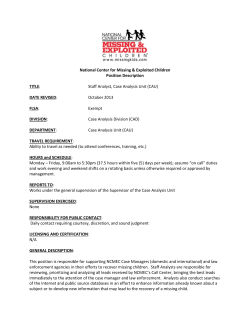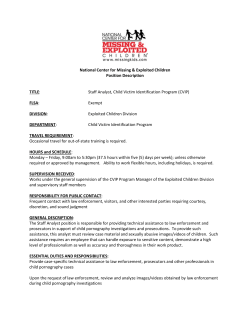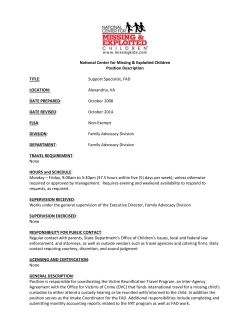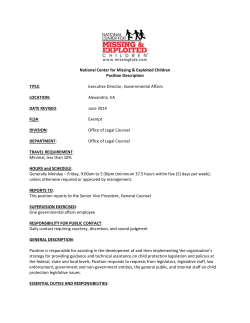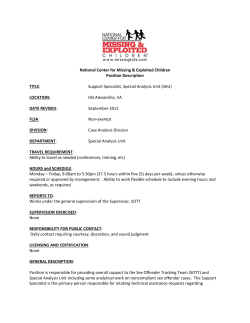
I
Investigative Checklist for First Responders This Checklist is meant to provide a framework of actions, considerations, and activities that may assist in performing competent, productive, and thorough missing/abducted-children investigations. First Responder [ ] Activate patrol-vehicle-mounted video camera, if circumstances warrant, when approaching the scene to record vehicles, people, and anything else of note for later investigative review. [ ] Interview parent(s)/guardian(s)/person who made the initial report. [ ] Confirm the child is in fact missing. [ ] Attempt to verify the child’s custody status. [ ] Identify the circumstances of the missing episode. [ ] Determine when, where, and by whom the missing child was last seen. [ ] Interview the individuals who last had contact with the child. [ ] Identify the child’s zone of safety for his or her age and developmental stage. [ ] Make an initial assessment, based on the available information, of the type of incident whether nonfamily abduction; family abduction; runaway; or lost, injured, or otherwise missing. [ ] Obtain a detailed description of the missing child, abductor, and any vehicles used. [ ] Secure photos/videos of the missing child/abductor, and don’t forget photos that may be available on cell phones. [ ] Evaluate whether the circumstances meet AMBER AlertTM criteria and/or other immediate communitynotification protocol if not already activated. Discuss plan activation with supervisor. [ ] Evaluate whether the circumstances warrant requesting the National Center for Missing & Exploited Children®’s (NCMEC) Team Adam. If a Child Abduction Response Team (CART) is in the area, does the child’s case meet their activation criteria? [ ] Relay detailed descriptive information to communications unit for broadcast updates. [ ] Determine need for additional personnel including investigative and supervisory staff. [ ] Brief and bring up-to-date all additional responding personnel. [ ] Identify and separately interview everyone at the scene. Make sure their interview and identifying information is properly recorded. To aid in this process, if possible, take pictures or record video images of everyone present. Video cameras affixed to patrol vehicles may be helpful with this task. [ ] Note name, address, home/business phone numbers of each person. [ ] Determine each person’s relationship to the missing child. [ ] Note information each person may have about the circumstances surrounding the missing episode. [ ] Determine when/where each person last saw the child. [ ] Ask each one, “What do you think happened to the child?” [ ] Obtain names/addresses/phone numbers of the child’s friends/associates and other relatives and friends of the family. [ ] Determine if any suspicious activity or people were seen in the area. [ ] Determine if any people were seen who seemed unusual, strange, or out-of-place. [ ] Continue to keep communications unit apprised of all appropriate developing information for broadcast updates. [ ] Obtain and note permission to search home or building where incident took place even if the premises have been previously searched by family members or others. [ ] Conduct an immediate, thorough search of the missing child’s home even if the child was reported missing from a different location. [ ] Seal/protect scene and area of the child’s home, including the child’s personal articles such as hairbrush, diary, photos, and items with the child’s fingerprints/footprints/teeth impressions, so evidence is not destroyed during or after the initial search and to help ensure items that could help in the search for and/or to identify the child are preserved. Determine if any of the child’s personal items are missing. If possible, photograph/take videos of these areas. [ ] Evaluate the contents and appearance of the child’s room/residence. [ ] Inquire if the child has access to the Internet and evaluate its role. Do not overlook activity on social-networking websites and teen chatlines. [ ] Ascertain if the child has a cell phone or other electronic communication device and obtain the most recent records of their use. [ ] Extend search to surrounding areas and vehicles, including those that are abandoned, and other places of concealment such as abandoned appliances, pools, wells, sheds, or other areas considered “attractive nuisances.” [ ] Treat areas of interest as potential crime scenes including all areas where the child may have been or was going to be located. [ ] Determine if surveillance or security cameras in the vicinity may have captured relevant information. This information may be used to help locate the child and/or corroborate or refute witness statements. [ ] Interview other family members, friends/associates of the child, and friends of the family to determine [ ] When each last saw the child. [ ] What they think happened to the child. [ ] If the child had complained about being approached by anyone. [ ] Review sex-offender registries to determine if registered individuals live/work in the area or might otherwise be associated with the case. Call NCMEC toll-free at 1-800-THE-LOST® (1-800-843-5678) to request assistance with this step. [ ] Ensure information regarding the missing child is entered into the National Crime Information Center’s (NCIC) Missing Person File no more than two hours after receipt of the report and any information about a suspected abductor is entered into the NCIC Wanted Person File. Carefully review NCIC categories before entering the case, and be sure to use the Child-Abduction flag whenever appropriate. [ ] Prepare flier/bulletin with the child/abductor’s photo and descriptive information. Distribute in appropriate geographic regions. Call NCMEC toll-free at 1-800-THE-LOST (1-800-843-5678) for assistance with this step. [ ] Prepare reports/make all required notifications. Supervisory Officer [ ] Obtain briefing and written reports from the first responding officer and other personnel at the scene. [ ] Decide if circumstances meet the protocol in place for activation of an AMBER Alert and/or other immediate community-notification systems if not already activated. [ ] Determine if additional personnel are needed to assist in the investigation. [ ] Establish a command post away from the child’s residence. [ ] Determine if additional assistance is necessary from [ ] State/Territorial Police. [ ] Missing-Children Clearinghouse. [ ] Federal Bureau of Investigation (FBI). [ ] Specialized Units. [ ] Victim-Witness Services. [ ] NCMEC’s Project ALERT®/Team Adam. [ ] CARTs. [ ] Confirm all the required resources, equipment, and assistance necessary to conduct an efficient investigation have been requested and expedite their availability. [ ] Ensure coordination/cooperation among all law-enforcement personnel involved in the investigation and search effort. [ ] Verify all required notifications are made. [ ] Ensure all agency policies and procedures are in compliance. [ ] Be available to make any decisions or determinations as they develop. [ ] Use media including radio, television, and newspapers to assist in the search throughout the duration of the case. Investigative Officer [ ] Obtain briefing from the first responding officer and other on-scene personnel. [ ] Verify the accuracy of all descriptive information and other details developed during the preliminary investigation. [ ] Initiate a neighborhood canvass using a standardized questionnaire. [ ] Obtain a brief, recent history of family dynamics. [ ] Correct and investigate the reasons for conflicting information offered by witnesses and other individuals. [ ] Collect article(s) of the child’s clothing for scent-tracking purposes. [ ] Review and evaluate all available information and evidence collected. [ ] Secure the child’s latest medical and dental records. [ ] Contact landfill management and request they delay or at least segregate garbage and dumping containers from key investigative areas in cases where it is suspected there may be imminent danger to the missing child. [ ] Develop and execute an investigative plan. [ ] Conduct a criminal-history background check on all principal suspects, witnesses, and participants in the investigation. [ ] Determine what additional resources and specialized services are required. [ ] Ensure details of the case have been reported to NCMEC. [ ] Prepare and update bulletins for local law-enforcement agencies, missing-children clearinghouse, FBI, and other appropriate agencies. [ ] Establish a phone hotline for receipt of tips and leads. Consider establishing an e-mail address and other methods of electronically receiving leads as well. [ ] Establish a leads-management system to prioritize leads and help ensure each one is reviewed and followed up on. Note: NCMEC has developed software, named the Simple Leads Management System, designed to manage and prioritize leads associated with missing-child investigations. It is available at no cost by calling NCMEC’s Missing Children Division toll-free at 1-800-THE-LOST (1-800-843-5678). This “pocket guide” is adapted from and to be used as a supplement to Missing and Abducted Children: A Law-Enforcement Guide to Case Investigation and Program Management. That guide contains additional investigative Checklists and materials. To request a free copy or technical assistance for specific cases, call NCMEC at 1-800-THE-LOST (1-800-843-5678). This project was supported by Grant No. 2013-MC-FX-K001 awarded by the Office of Juvenile Justice and Delinquency Prevention, Office of Justice Programs, U.S. Department of Justice. This document is provided for informational purposes only and does not constitute legal advice or professional opinion on specific facts. Information provided in this document may not remain current or accurate, so recipients should use this document only as a starting point for their own independent research and analysis. If legal advice or other expert assistance is required, the services of a competent professional should be sought. Points of view or opinions in this document are those of the author and do not necessarily represent the official position or policies of the U.S. Department of Justice. Copyright © 2004, 2006, and 2011 National Center for Missing & Exploited Children. All rights reserved. National Center for Missing & Exploited Children®, 1-800-THE-LOST®, and Project ALERT® are registered trademarks of the National Center for Missing & Exploited Children. NCMEC Order #88.
© Copyright 2025
